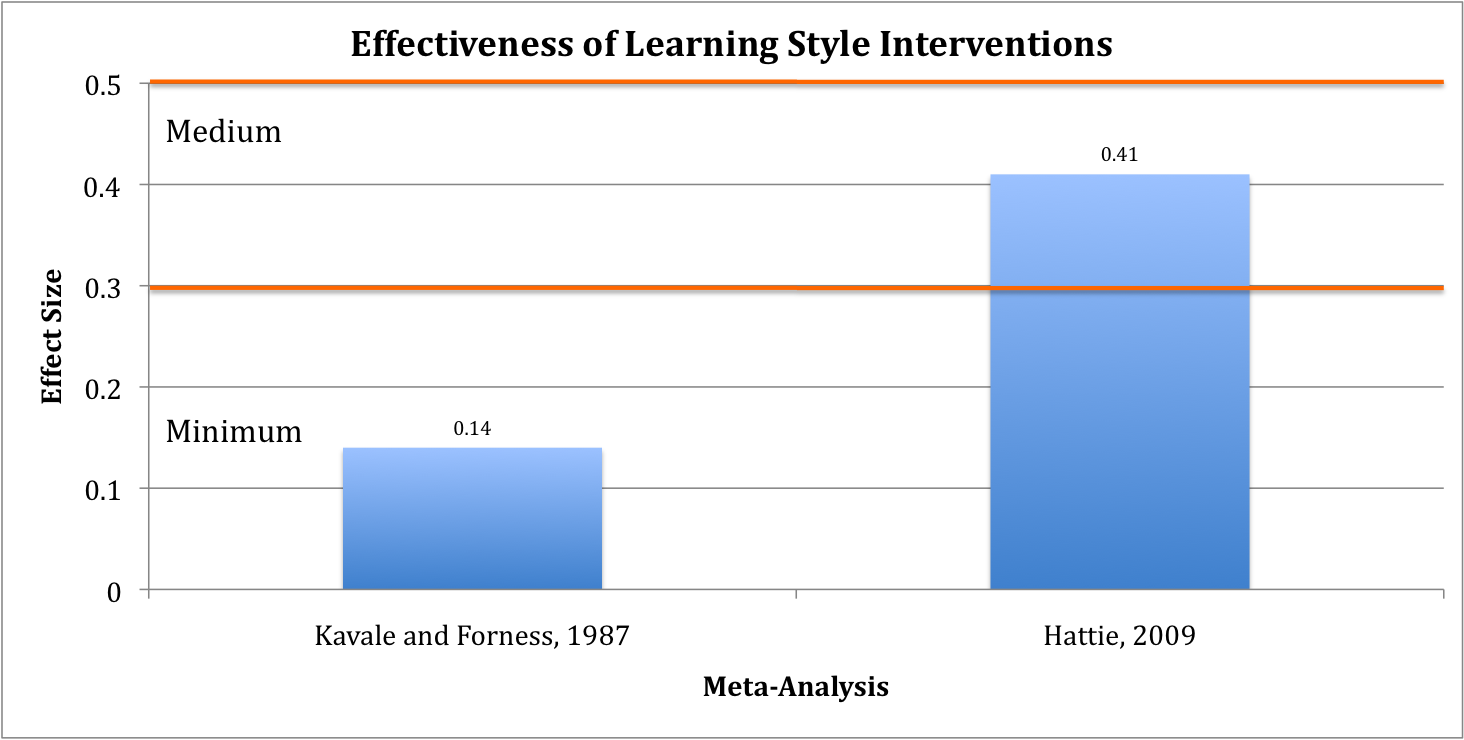Do we get better results when teachers match individual learning styles to instructional methods?
Why is this question important? Learning style interventions have an intuitive appeal among educators and the public and thus are found from kindergarten through graduate school. Despite the appeal of these interventions, examining the evidence for learning styles is essential. It is always important to use effective practices and avoid ineffective ones. Given the current financial struggles and budget cuts impacting schools after the crash of 2008, it is important to use effective practices and avoid ineffective practices. Ineffectiveness is always too expensive both in terms of dollars and opportunities lost for the students.
See further discussion below.

Source(s): Substance Over Style: Assessing the Efficacy of Modality Testing and Teaching, 1987; and Visible Learning: A Synthesis of Over 800 Meta-Analyses Relating to Achievement, 2009
Result(s): The primary findings of Substance Over Style: Assessing the Efficacy of Modality Testing and Teaching indicated that neither modality assessment nor modality instruction could act as a powerful agent for school reform. Kavale and Forness identified an effect size of 0.14 associated with matching learning style to instruction. When compared with a control group, learning style preference groups receiving instruction matched to the subjects preferred style showed only modest gains.
In Visible Learning: A Synthesis of Over 800 Meta-Analyses Relating to Achievement, Hattie calculated a higher effect size of 0.41 for learning styles. The Hattie meta-analysis ranked matching learning styles to instruction 62nd out of the 138 practices for effectiveness.
Implication(s): Kavale and Forness found little support for the modality matching. They concluded that, although intuitively appealing, matching learning styles to instruction should be dismissed.
Hattie concluded that learning style was somewhat important, but contradictions among studies regarding learning styles and learning strategies, blending of aptitude-treatment interactions (ATI) and learning style interventions, and finally the lack of rigorous study designs in much of the research, led to concerns about the designing interventions based upon the approach.
The difference in effect size between the Kavale and Forness study and the Hattie study indicates the need for additional research. The effect sizes published in these two studies suggest the need for a cost-benefit analysis to answer the following question: Do improvements in student achievement derived from learning style interventions outweigh the costs associated with implementing modality matching practices?
Author(s): K. A. Kavale and S. R. Forness (Substance Over Style: Assessing the Efficacy of Modality Testing and Teaching, 1987); and John Hattie (Visible Learning: A Synthesis of Over 800 Meta-Analyses Relating to Achievement, 2009)
Publisher(s): Exceptional Children (Substance Over Style: Assessing the Efficacy of Modality Testing and Teaching, 1987); and Routledge (Visible Learning: A Synthesis of Over 800 Meta-Analyses Relating to Achievement, 2009)
Study Description(s): The Kavale and Forness study is a meta-analysis based on a quantitative synthesis of findings from 39 studies on the topic of learning style practices.
The Hattie report, a comprehensive summary of research available until 2009, includes 8 meta-analyses of 411 studies.
Definition(s):
- Aptitude-treatment interaction (ATI): The concept that some instructional strategies (treatments) are more or less effective for particular individuals depending on their specific abilities. As a theoretical framework, ATI suggests that optimal learning results when the instruction is exactly matched to the aptitudes of the learner (L. Cronbach and R. Snow, 1977). Learning style is considered a subset of ATI.
- Learning style: The view that different people learn information in different ways; for example, that some are visual learners and others auditory learners, and some are left-brain students, others right-brain. The meshing hypothesis, the most common theory regarding learning styles, asserts that matching instruction with the preferences of the learner, such as visually presenting information to a visual learner, leads to more effective learning.
- Modality model: An education model built around the notion that all people are unique, each having strengths and weaknesses as well as learning preferences. Student achievement is enhanced by teaching that matches modalities of instruction to a student’s preferred modalities of learning.
Citation(s): Kavale, K. A., and S. R. Forness (1987). Substance Over Style: Assessing the Efficacy of Modality Testing and Teaching, Exceptional Children, Vol. 54, No. 3, pp. 228–39;
Hattie, J. (2009). Visible Learning: A Synthesis of Over 800 Meta-Analyses Relating to Achievement. Routledge
